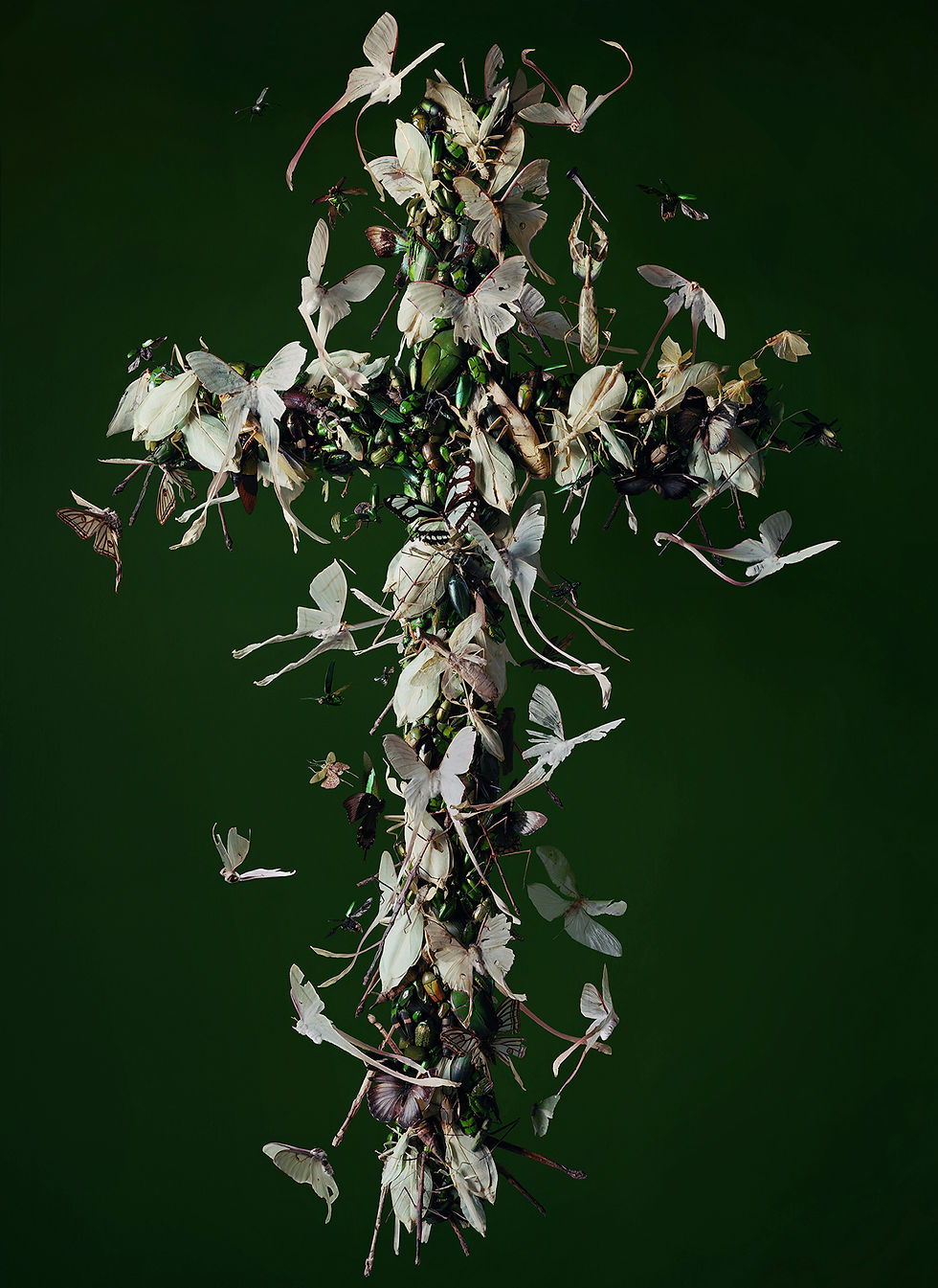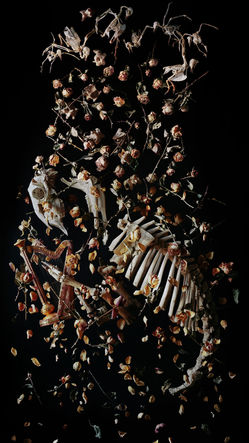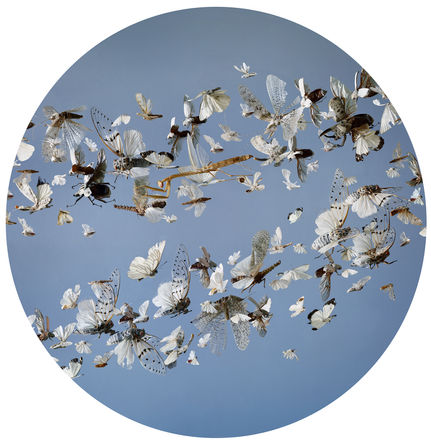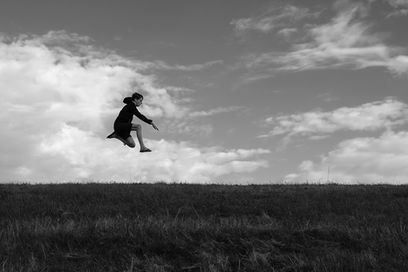
INTERVIEW
April 19, 2024
PRIMAL INSTINCT
Photography by Tara Sellios
Interview by Melanie Meggs
Tara Sellios is a multidisciplinary artist who explores themes of mortality, fragility, and impermanence in her artistry. She primarily works with large format photography, but also incorporates drawing, sculpture, and installation into her practice. Since completing her BFA in photography and art history in 2010, she has showcased her works both locally and nationally. Currently, Tara is preparing for several shows throughout Italy and she is preparing for a solo exhibition at the Fitchburg Art Museum in Fitchburg, MA, USA. Alongside her exhibitions, Tara actively participates in artist lectures and will be facilitating workshops this year, showcasing her deep understanding and passion for her craft.
Using an 8x10 view camera, Tara meticulously plans and executes her photographs, often incorporating organic materials such as animal skeletons and dried insects. These elements, along with religious symbolism, result in visually striking still-life images that are intended to be printed larger than life. Tara’s work explores the duality of life and death, and the instinctive, carnal nature that exists within all living creatures. She draws inspiration from the concept of morality and its relationship to mortality, as seen in the history of art from altarpieces to Dutch vanitas paintings. By creating images that are seductive and beautiful despite their seemingly grotesque and morbid subject matter, Tara challenges viewers to confront their own mortality and the fragility of life.
Tara describes her work as a theater production or a book, with each series serving as an act or chapter. Her earlier work focused on themes of pleasure and indulgence, often using wine and blood as allegorical symbols. However, in her current work, she explores a new narrative world where the feast has dried up and pleasure has transformed into something more apocalyptic. Insects and reptiles play a significant role in her work, representing the primal instinct that exists within all living creatures.
Through her work, Tara seeks to capture the restlessness and vulnerability of life, while also exploring themes of transcendence and the human experience. She remains true to her original vision, staying as close as possible to the natural elements used in her work. Tara’s thought-provoking and visually captivating pieces continue to push the boundaries of photography and art as a whole.
Read on to learn more about Tara Sellios, her inspirations, and her creative process.

“As long as I remember, art was always something that I was drawn to, even when I was young. Art had a mysterious, magical quality to it that fascinated me and even frightened me a little, as if it were a secret language or other world. My impulse to create art was always instinctive. It was something I had to do that ran very deep. I’ve always felt the need to get something out of me.”
IN CONVERSATION WITH TARA SELLIOS
THE PICTORIAL LIST: Hello Tara, thank you for sharing your inspiring photography with us. Welcome to The Pictorial List! Tell our readers about yourself. When did art enter your life? And talk to us about how you chose photography as the medium to play an important role in your art.
TARA SELLIOS: Thank you for giving me the opportunity to share my work! It is an honor. I currently reside in my live/work studio in Boston, Massachusetts (USA). I grew up a bit north of here outside of the city in the suburbs. There actually is not a specific moment or romantic story of when art entered my life or when I decided to be an artist. As long as I remember, it was always something that I was drawn to, even when I was young.
My main focus was drawing and painting before photography. I took some photography classes for fun when I was younger at weekend programs in local art schools where I learned to use the darkroom, but never thought it would be something that I was going to pursue as my primary medium. I went to art school to study fine art. When I got there, sitting in a room full of people and painting a pile of boxes in complementary colors did not appeal to me. I craved freedom and wanted my time to be spent focusing on conceptual content and not having rigid assignments and exercises. Photography intimidated me because I didn’t know much about it, but two weeks into school I switched into the program and it was certainly the right decision. I came to realize that I could essentially paint with the camera, which is still my mentality in my approach to photography. Working with the rendering of light to create images is something that drew me in. There is also something impactful in the “realness” of a photograph, at least in terms of my work (I know that the word “real” is often debated in regard to photography). Using actual skeletons and objects has a different weight to it than a painting of the object, as a relic has. I like that these otherworldly scenes that I create have actually existed. I enjoy drawing as well, but it is a different experience. I’m glad I work in multiple mediums, as it does feel really good to let loose and make a drawing.
TPL: What are some of the challenges you have faced as a woman photographer? Were you able to overcome them? What did you learn from them? What advice can you share with other women photographers out there?
TARA: I must say that I have been very fortunate to not have had many challenges in that regard as an artist. Any challenges were outside of that realm. I have been so fortunate to have been surrounded by so many strong, supportive women (some artists, some not) who feel more like family than friends. I am grateful for the women, my sisters, that have entered my circle. They come from different walks of life and different places, but we all have a common thread of creativity and a bit of wildness. My advice to woman photographers is to seek out and surround yourself with other strong women, and nurture those relationships. They are more valuable than anything.
TPL: How do you believe art can convey the complex concept of mortality and morality? What drives you to create images that capture the essence of existence and the primal nature of life? How has the depiction of the end of the world and Hell in art and literature influenced your work?
TARA: Throughout history, art has had a place in society of acting as a reminder, warning, or way to teach, especially within the realm of sacred spaces. Art’s role was one of storytelling, reverence and meditation. The concept of morality and mortality is present in that there are many works of art that act as a reminder that earthly pleasures and carnal self indulgence can lead to downfall and distraction from spiritual things. Life is fleeting and temporary. I had a very strict Christian upbringing that was present my whole life. Since a very young age, the concept of sin and the judgment and punishment for that in Hell were ever present. It was pretty traumatic in the way in which it was delivered. That being said, constantly hearing stories from the Bible my whole life has certainly impacted my work. As a text, it is an extremely vivid book, filled with intense, often surreal imagery, metaphor and symbolism. The concept of sin and punishment that was so prominent in my upbringing is one that I constantly visit in my work, as if I am debating it and rationalizing it.
Why must we face such harsh consequences for acting on sensory impulses, both big and small? It’s pretty amazing the quantity of images there are throughout history of depictions of Hell, and not just in Christianity. There’s a deep, dark scary place filled with monsters, tortures and demons in many cultures. What draws me to the paintings is despite their darkness, there is something really curious and surreal about them, and often there is an uncanny sense of humor that appears. I love their rich, hot color palettes and the festering chaos they possess. I spent 15 years working in nightclubs to support myself financially, a job I finally took the plunge of leaving, and a lot of these paintings of Hell often reminded me of some twisted nightclub. All of these elements have become woven into my work.
My approach to creating images that capture primal instinct, carnality and existence is more visceral and earth centered. The natural world is very cyclical in nature, constantly following a life/death/life cycle. All things are a part of this and exist in this inevitable flow. We have to live in this spiral with our human, earthly consciousness, which can be difficult to fathom. However, the impermanence of it all can make beauty and wonder even more powerful.
TPL: How do you balance the seemingly contradictory themes of beauty and grotesque in your images? You use dried specimens and skeletons as symbols of primal instinct - can you elaborate on this choice and its significance?
TARA: I don’t think of the concept of beauty and the concept of the grotesque as separate. There can be vast beauty in the grotesque, which makes it alluring and unsettling. I try to portray the gestures and marks in my photographs with elegance, despite apparent harshness. Texture, light and color, anything that appeals to the senses, can instigate the notion of beauty, but there can be beauty in the drama and emotion of an image. The skeletons and dried specimens entered the story as a response to my older work and as a continuation into the next chapter of the story. I had reached a point of completion with the materials I used to work with, such as fleshy specimens and wine, and was tired of being chained to using the tabletop. The feast is over, the wine has dried up and the flesh has withered away to the bone, but the chapter transforms into a new narrative world where the earth begins to take over in a sort of apocalyptic way. I wanted more freedom and a feeling of weightlessness in my images, for the still life to become more animated. The insects and other organic materials begin to take over. I often think about conveying that fear that one can feel in the woods by yourself as darkness starts to set in, that sort of shadowy feeling of being in a powerful, wild place teaming with creatures and a force way beyond oneself.
TPL: Can you speak more about the process of creating your images, from research to the final photograph? Please share your mental state when you embark on a new project. What are the guidelines you give yourself, and how much planning do you typically do? How do you determine when to start and stop?
TARA: My work is extremely process oriented, with many layers and steps that all play off of each other. The initial stage is research based, which involves reading and looking at whatever art historical figures are speaking to me at the moment, music, movies, and just living. All of it feeds the work, which I think is true for a lot of artists - whatever is part of our “diet” shows up in some way, whether subtle or not. My state of mind when I am beginning a new piece or entering an intense period of creation is an overbearing feeling that something needs to get out. I can become pretty obsessed, and it overtakes me. It is almost as if my work has a life of its own. It tells me when it’s done.
Once ideas start coming through, I jot down concepts, words and images that come to mind, some of which are often very vague. They can be colors, feelings or actions that I want the imagery to manifest. As more solid concepts begin to arise, I make a shot list of sorts. I then make preliminary watercolor sketches to establish the concept visually and do most of my problem solving there. From the sketch, I can figure out colors and materials needed to build the photographic arrangement, which is a sculptural endeavor. Using an 8x10 view camera and natural light, the scene is photographed with color film and then scanned. The only photoshop work that I do is typical adjustments and removing the wire, glue and other base structures that hold everything together.
TPL: How do you hope your images will make viewers contemplate their own mortality and the concept of transcendence through suffering?
TARA: As an artist, I tend to let go of a work when it is completed, meaning when it is done, it is out in the world and takes on a life of its own. It is out of my control at that point. Viewers will have their own interpretation and meditations on it depending on their experience in life, which sometimes means that what they find in a piece has nothing to do with my intention. I hope that my work makes people think and dig deep into thoughts and feelings that they haven’t felt before or often. I also want people to feel a sense of wonder and curiosity when looking at the work, in the way that beauty is often more powerful in its ephemerality. Beauty is something you can’t hold onto, and it exists simultaneously in a world that has a lot of darkness and pain. My work has a lot of darkness and lightness, as the two coexist together in a dance. The psyche possesses both and one does not exist without the other. I hope viewers feel that presence in my work and that it activates emotions or thoughts that are specific to themselves.
Beauty is something you can’t hold onto, and it exists simultaneously in a world that has a lot of darkness and pain.

TPL: Can you explain your process of using natural light instead of studio lights, and using an 8x10 view camera in your photography?
TARA: Nothing renders light and color like 8x10 film. It has a radiant, painterly quality to it. Ideally, the photographs are intended to be presented at a grandiose size, in the vein of painting, so the 8x10 negative is the best option to enlarge the image and maintain hyper detail. The detail is crucial to my work, as I want the textures, tones and colors to appeal to the senses. Natural light is just so stunning and simple. It is a light that moves and comes from organic elements. The way that it renders an insect wing, for example, would not be achieved in the same way with artificial light. I enjoy looking at the paintings of Vermeer and his use of light in his work. I find it very photographic in nature, which most likely has to do with his use of the camera obscura.
TPL: Who was your first inspiration, in this new way of engaging and defining the world around you? Is there a profound moment you shared that has stayed with you until today? Would you mind sharing that with us?
TARA: Having grown up in such a restricted environment, my discovery of music changed everything for me, especially of the rock, punk, indie etc. persuasion. I was mostly surrounded by church music or “nice” music. Music really became my world and I went to see bands play every weekend. The intensity of emotion, sound and deep, often dark, feelings expressed felt so cathartic. I remember I was twelve years old the first time I heard Nine Inch Nails I thought, “what IS this?!” I had never heard anything like that before, and experiencing almost a shock like that is prominent in my mind. I didn’t know music could be that. It led me to bartending in nightclubs and music venues for fifteen years, and as I mentioned, it is a career I just left a few months ago to pursue my art. It was time to go for many reasons, but one thing that started to bother me was that I had musical burnout. I didn’t want to listen to anything on my own time, but thankfully, that has healed. It didn’t take long. It feels good to attend concerts now as a pedestrian.
TPL: What other photographers or artists have influenced you, and how? What impact have they made in the way you approach and create your work in photography?
TPL: What advice would you give to a photographer starting a new project, what are the pros and cons and what are some of the lessons you have learned along the way?
TARA: I think that starting a new project is exciting! I don’t really see beginning something new as having “pros and cons”, at least for me. The work begins to take shape and may change from your original intention, but that is usually for the best, as in a lot of life situations. I would say be open to the work revealing itself without clinging too tightly to your own rigid ideas. Don’t rush and don’t push the work in one direction if it is screaming to go in another. The important thing when starting something new is to show up, continue to work, and be okay with the unknown.
TPL: What is on the horizon for Tara Sellios? Are there any new projects you would like to share with us?
TARA: These days, I am always working on several projects at once. Most of them are open ended and I just keep adding to them. My main focus at the moment is a series called Ad Altiora Tendo, which means “I strive for higher things” in Latin. Having a lot of deep, rich greens and earth tones, I want it to feel like a lush, subtly psychedelic forest. It explores themes of transcendence and regeneration through suffering and sacrifice. Some of the inspiration is drawn from the martyrs, those who have voluntarily suffered for refusing to denounce their faith and beliefs and ultimately transcend to a higher, more spiritual place. There is some violence in the imagery, but it is portrayed with natural elements of beauty, like flowing red flowers in the place of blood. Ultimately, the work is becoming more celebratory, with more foliage and musical instruments, and probably other elements that will arrive in the future. I have spent much of my time focusing on the research of Hell within art history and have read Dante’s Divine Comedy three times. I’m at a point of moving forward with my work where I want to start focusing more on moving toward and ultimately to, paradise. I have a separate series revolving around in the back of my head in regard to that heavenly/paradise concept with a series that is mostly blue and white.
TPL: When you are not creating your art through your photography, what else could we find Tara doing?
TARA: Creating art for me also involves the drawing aspect, so I will often be making drawings when I am not working on a photograph or planning other projects while working on one. I feel like I’m always working in some way! When not creating art, I spend a lot of time in the woods hiking. As a city dweller, trips to nature are much needed. I feel a sense of peace and get a lot of ideas and thinking done out there. It grounds me.

In the grand tapestry of contemporary art, Tara Sellios stands out as a weaver of the morose and the magnificent, challenging the viewer to peer through the lens of mortality and emerge with a sense of awe. Her multidisciplinary approach defies simple categorization, merging photography with sculpture and installation, to craft a body of work that is as contemplative as it is confrontational.
Tara’s art, a visual feast that confronts the viewer with the stark reality of life’s fleeting nature, is profound in its execution and resonant in its message. Tara creates a dialogue with the past while deeply engaging with the present. The result is a series of works that are not only visually arresting but layered with meaning and rich in context.
As viewers, we are invited to explore the interplay of life and death, of decay and beauty, and to find within that juxtaposition a reflection of our own existential journey. With her upcoming exhibitions and workshops, Tara continues to expand her narrative and share her profound reflections with the world. Whether standing amidst her large-scale photographs or participating in her educational endeavors, one is compelled to reconsider the essence of human experience through her eyes.
As we anticipate her future works and exhibitions, we are reminded of the power of art to not only capture but also transcend the human condition. Tara Sellios’ oeuvre is a testament to the enduring quest for understanding and the unyielding pursuit of beauty in all its forms — even in the presence of the inevitable end. Her work, a poignant reminder of our own mortality, invites us to embrace the fragility of life and find solace in the art that imitates its impermanence.





























































